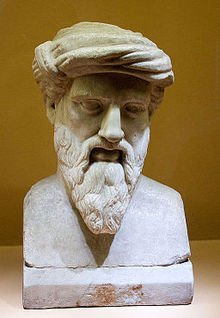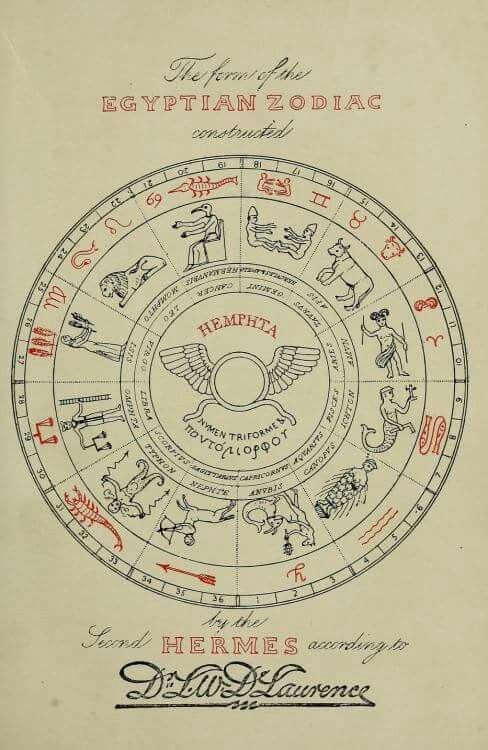THE HELIOCENTRIC BALL EARTH CONSPIRACY GENESIS
THE HELIOCENTRIC BALL EARTH CONSPIRACY GENESIS

Bust of Pythagoras of Samos in the
Capitoline Museums, Rome.
500 BCE
Pythagoras was first to propose the ball earth model, he is considered the honorary first Mason and founder of the Order around 500 BC, contemporary to Siddhartha Gautama Buddha and the Babylonian exile. He has organized numerous loose Egyptian cults into the Pythagorean mystery school which grew to become the Masonic Order.
450 BCE
Philolaus (c. 470 – c. 385 BCE) described an astronomical system in which a Central Fire (different from the Sun) occupied the centre of the universe, and a counter-Earth, the Earth, Moon, the Sun itself, planets, and stars all revolved around it, in that order outward from the centre.
Heraclides Ponticus (387–312 BCE) proposed that the Earth rotates on its axis. Aristarchus of Samos (c. 310 BCE – c. 230 BCE) was the first to advance a theory that the earth orbited the sun.
150 BCE
Further mathematical details of Aristarchus's heliocentric system were worked out around 150 BCE by the Hellenistic astronomer Seleucus of Seleucia.
Though Aristarchus's original text has been lost, a reference in Archimedes' book The Sand Reckoner (Archimedis Syracusani Arenarius & Dimensio Circuli) describes a work by Aristarchus in which he advanced the heliocentric model.
Obviously it would take some time to develop these ideas, so this one was on hold until Ptolemy, around 150 CE has introduced the nested spheres with the Pythagorean ball earth at the centre, stationary no less, since the flat stationary earth was common knowledge, because it is in the bible, and at that time the Church and State were united, so the official doctrine was well known. Besides the point, it is true the fact that echoed by all ancient cultures.
The next step was to replace the stationary ball earth with the sun and send the earth flying along with all planets in orbit around it. For this the Order has, I suspect, created a fictional character, the infamous Nicolaus Copernicus in 1500's who was reportedly inspired by the Arabic astronomers...
1500
In an early unpublished manuscript of De Revolutionibus (which still survives), Copernicus mentioned the (non-heliocentric) 'moving Earth' theory of Philolaus and the possibility that Aristarchus also had a 'moving Earth' theory (though it is unlikely that he was aware that it was a heliocentric theory). He removed both references from his final published manuscript.
Copernicus was probably aware that Pythagoras's system involved a moving Earth. The Pythagorean system was mentioned by Aristotle. Copernicus owned a copy of Giorgio Valla's De expetendis et fugiendis rebus, which included a translation of Plutarch's reference to Aristarchus's heliostaticism.
In Copernicus's dedication of On the Revolutions to Pope Paul III—which Copernicus hoped would dampen criticism of his heliocentric theory by "babblers... completely ignorant of [astronomy]"—the book's author wrote that, in rereading all of philosophy, in the pages of Cicero and Plutarch he had found references to those few thinkers who dared to move the Earth "against the traditional opinion of astronomers and almost against common sense."
The prevailing theory during Copernicus's lifetime was the one that Ptolemy published in his Almagest c. 150 CE; the Earth was the stationary center of the universe. Stars were embedded in a large outer sphere that rotated rapidly, approximately daily, while each of the planets, the Sun, and the Moon were embedded in their own, smaller spheres. Ptolemy's system employed devices, including epicycles, deferents and equants, to account for observations that the paths of these bodies differed from simple, circular orbits centered on the Earth.
Beginning in the 10th century, a tradition criticizing Ptolemy developed within Islamic astronomy, which climaxed with Ibn al-Haytham of Basra's Al-Shukūk 'alā Baṭalamiyūs ("Doubts Concerning Ptolemy"). Several Islamic astronomers questioned the Earth's apparent immobility, and centrality within the universe. Some accepted that the earth rotates around its axis, such as Abu Sa'id al-Sijzi (d. c. 1020).
According to al-Biruni, al-Sijzi invented an astrolabe based on a belief held by some of his contemporaries "that the motion we see is due to the Earth's movement and not to that of the sky." That others besides al-Sijzi held this view is further confirmed by a reference from an Arabic work in the 13th century which states:
According to the geometers [or engineers] (muhandisīn), the earth is in constant circular motion, and what appears to be the motion of the heavens is actually due to the motion of the earth and not the stars.
In the 12th century, Nur ad-Din al-Bitruji proposed a complete alternative to the Ptolemaic system (although not heliocentric). He declared the Ptolemaic system as an imaginary model, successful at predicting planetary positions, but not real or physical. Al-Bitruji's alternative system spread through most of Europe during the 13th century, with debates and refutations of his ideas continued up to the 16th century.
Mathematical techniques developed in the 13th to 14th centuries by Mo'ayyeduddin al-Urdi, Nasir al-Din al-Tusi, and Ibn al-Shatir for geocentric models of planetary motions closely resemble some of those used later by Copernicus in his heliocentric models. Copernicus used what is now known as the Urdi lemma and the Tusi couple in the same planetary models as found in Arabic sources. Furthermore, the exact replacement of the equant by two epicycles used by Copernicus in the Commentariolus was found in an earlier work by Ibn al-Shatir (d. c. 1375) of Damascus. Ibn al-Shatir's lunar and Mercury models are also identical to those of Copernicus.
This has led some scholars to argue that Copernicus must have had access to some yet to be identified work on the ideas of those earlier astronomers. However, no likely candidate for this conjectured work has yet come to light, and other scholars have argued that Copernicus could well have developed these ideas independently of the late Islamic tradition. Nevertheless, Copernicus cited some of the Islamic astronomers whose theories and observations he used in De Revolutionibus, namely al-Battani, Thabit ibn Qurra, al-Zarqali, Averroes, and al-Bitruji.
1543
Copernicus's major work on his heliocentric theory was Dē revolutionibus orbium coelestium (On the Revolutions of the Celestial Spheres), published in the year of his death, 1543. He had formulated his theory by 1510. "He wrote out a short overview of his new heavenly arrangement [known as the Commentariolus, or Brief Sketch], also probably in 1510 [but no later than May 1514], and sent it off to at least one correspondent beyond Varmia [the Latin for "Warmia"]. That person in turn copied the document for further circulation, and presumably the new recipients did, too..."
Copernicus's Commentariolus summarized his heliocentric theory. It listed the "assumptions" upon which the theory was based, as follows:
There is no one center of all the celestial circles or spheres.
The center of the earth is not the center of the universe, but only the center towards which heavy bodies move and the center of the lunar sphere.
All the spheres surround the sun as if it were in the middle of them all, and therefore the center of the universe is near the sun.
The ratio of the earth's distance from the sun to the height of the firmament (outermost celestial sphere containing the stars) is so much smaller than the ratio of the earth's radius to its distance from the sun that the distance from the earth to the sun is imperceptible in comparison with the height of the firmament.
Whatever motion appears in the firmament arises not from any motion of the firmament, but from the earth's motion. The earth together with its circumjacent elements performs a complete rotation on its fixed poles in a daily motion, while the firmament and highest heaven abide unchanged.
What appear to us as motions of the sun arise not from its motion but from the motion of the earth and our sphere, with which we revolve about the sun like any other planet. The earth has, then, more than one motion.
The apparent retrograde and direct motion of the planets arises not from their motion but from the earth's. The motion of the earth alone, therefore, suffices to explain so many apparent inequalities in the heavens.
De revolutionibus itself was divided into six sections or parts, called "books":
General vision of the heliocentric theory, and a summarized exposition of his idea of the World
Mainly theoretical, presents the principles of spherical astronomy and a list of stars (as a basis for the arguments developed in the subsequent books)
Mainly dedicated to the apparent motions of the Sun and to related phenomena
Description of the Moon and its orbital motions
Exposition of the motions in longitude of the non-terrestrial planets
Exposition of the motions in latitude of the non-terrestrial planets
SUCCESSORS
Georg Joachim Rheticus could have been Copernicus's successor, but did not rise to the occasion. Erasmus Reinhold could have been his successor, but died prematurely. The first of the great successors was Tycho Brahe (though he did not think the Earth orbited the Sun), followed by Johannes Kepler, who had collaborated with Tycho in Prague and benefited from Tycho's decades' worth of detailed observational data.
Despite the near universal acceptance later of the heliocentric idea (though not the epicycles or the circular orbits), Copernicus's theory was originally slow to catch on. Scholars hold that sixty years after the publication of The Revolutions there were only around 15 astronomers espousing Copernicanism in all of Europe: "Thomas Digges and Thomas Harriot in England; Giordano Bruno and Galileo Galilei in Italy; Diego Zuniga in Spain; Simon Stevin in the Low Countries; and in Germany, the largest group—Georg Joachim Rheticus, Michael Maestlin, Christoph Rothmann (who may have later recanted), and Johannes Kepler." Additional possibilities are Englishman William Gilbert, along with Achilles Gasser, Georg Vogelin, Valentin Otto, and Tiedemann Giese.
Arthur Koestler, in his popular book The Sleepwalkers, asserted that Copernicus's book had not been widely read on its first publication. This claim was trenchantly criticised by Edward Rosen, and has been decisively disproved by Owen Gingerich, who examined nearly every surviving copy of the first two editions and found copious marginal notes by their owners throughout many of them. Gingerich published his conclusions in 2004 in The Book Nobody Read.
The intellectual climate of the time "remained dominated by Aristotelian philosophy and the corresponding Ptolemaic astronomy.
At that time there was no reason to accept the Copernican theory, except for its mathematical simplicity [by avoiding using the equant in determining planetary positions]." Tycho Brahe's system ("that the earth is stationary, the sun revolves about the earth, and the other planets revolve about the sun") also directly competed with Copernicus's. It was only a half-century later with the work of Kepler and Galileo that any substantial evidence defending Copernicanism appeared, starting "from the time when Galileo formulated the principle of inertia...[which] helped to explain why everything would not fall off the earth if it were in motion." "[Not until] after Isaac Newton, also high Mason, formulated the universal law of gravitation and the laws of mechanics [in his 1687 Principia], which unified terrestrial and celestial mechanics, was the heliocentric view generally accepted." Sir Isaac Newton has had the apple incident in 1666. The rest is history.
Parts sourced from Wikipedia.
♡
_ \ \ | / / _
